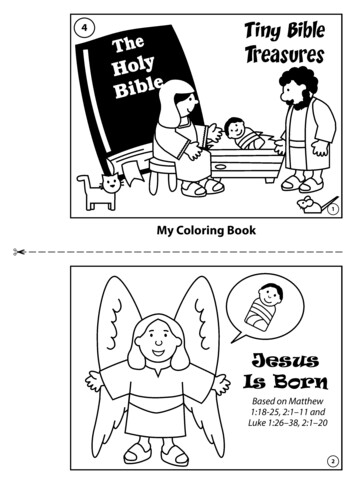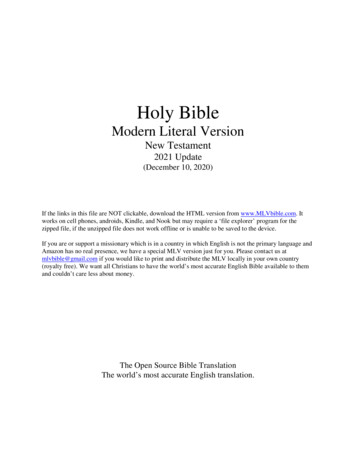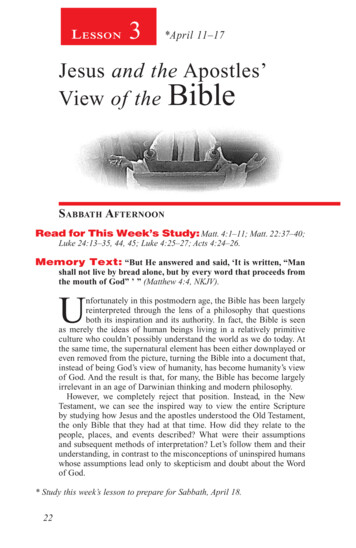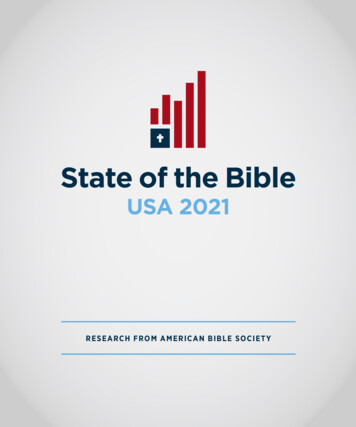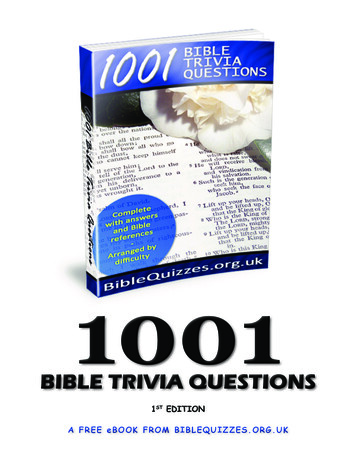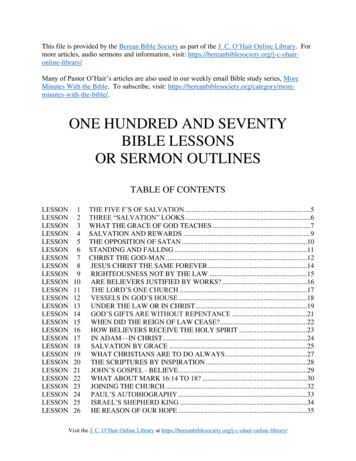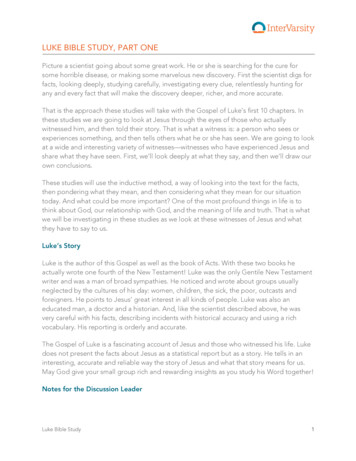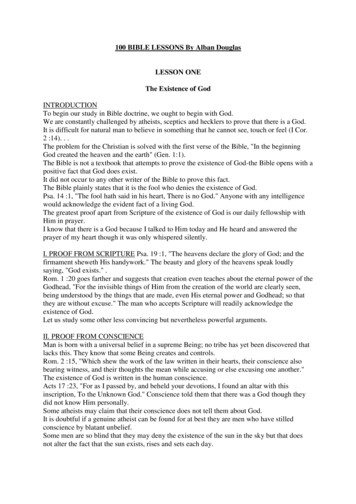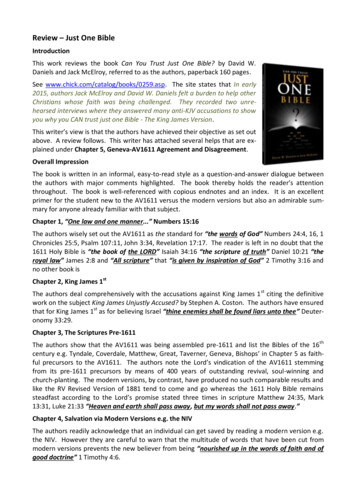
Transcription
Review – Just One BibleIntroductionThis work reviews the book Can You Trust Just One Bible? by David W.Daniels and Jack McElroy, referred to as the authors, paperback 160 pages.See www.chick.com/catalog/books/0259.asp. The site states that In early2015, authors Jack McElroy and David W. Daniels felt a burden to help otherChristians whose faith was being challenged. They recorded two unrehearsed interviews where they answered many anti-KJV accusations to showyou why you CAN trust just one Bible - The King James Version.This writer’s view is that the authors have achieved their objective as set outabove. A review follows. This writer has attached several helps that are explained under Chapter 5, Geneva-AV1611 Agreement and Disagreement.Overall ImpressionThe book is written in an informal, easy-to-read style as a question-and-answer dialogue betweenthe authors with major comments highlighted. The book thereby holds the reader’s attentionthroughout. The book is well-referenced with copious endnotes and an index. It is an excellentprimer for the student new to the AV1611 versus the modern versions but also an admirable summary for anyone already familiar with that subject.Chapter 1, “One law and one manner.” Numbers 15:16The authors wisely set out the AV1611 as the standard for “the words of God” Numbers 24:4, 16, 1Chronicles 25:5, Psalm 107:11, John 3:34, Revelation 17:17. The reader is left in no doubt that the1611 Holy Bible is “the book of the LORD” Isaiah 34:16 “the scripture of truth” Daniel 10:21 “theroyal law” James 2:8 and “All scripture” that “is given by inspiration of God” 2 Timothy 3:16 andno other book isChapter 2, King James 1stThe authors deal comprehensively with the accusations against King James 1 st citing the definitivework on the subject King James Unjustly Accused? by Stephen A. Coston. The authors have ensuredthat for King James 1st as for believing Israel “thine enemies shall be found liars unto thee” Deuteronomy 33:29.Chapter 3, The Scriptures Pre-1611The authors show that the AV1611 was being assembled pre-1611 and list the Bibles of the 16thcentury e.g. Tyndale, Coverdale, Matthew, Great, Taverner, Geneva, Bishops’ in Chapter 5 as faithful precursors to the AV1611. The authors note the Lord’s vindication of the AV1611 stemmingfrom its pre-1611 precursors by means of 400 years of outstanding revival, soul-winning andchurch-planting. The modern versions, by contrast, have produced no such comparable results andlike the RV Revised Version of 1881 tend to come and go whereas the 1611 Holy Bible remainssteadfast according to the Lord’s promise stated three times in scripture Matthew 24:35, Mark13:31, Luke 21:33 “Heaven and earth shall pass away, but my words shall not pass away.”Chapter 4, Salvation via Modern Versions e.g. the NIVThe authors readily acknowledge that an individual can get saved by reading a modern version e.g.the NIV. However they are careful to warn that the multitude of words that have been cut frommodern versions prevents the new believer from being “nourished up in the words of faith and ofgood doctrine” 1 Timothy 4:6.
2Chapter 5, Geneva-AV1611 Agreement and DisagreementChapter 5 of Can You Trust Just One Bible? has been this writer’s main focus for this review for reasons that follow.The authors commendably highlight the shortcomings of the Geneva Bible with respect to the 1611Holy Bible, Chapter 5 The Geneva Bible – What’s Wrong With It? though they do state that the Geneva Bible was a faithful precursor to the 1611 Holy Bible and very close to it. See remarks onChapter 3. They then cite as among the shortcomings of the Geneva Bible the following scriptureslisted in order as cited where the Geneva Bible is in error and corrected by the 1611 Holy Bible,Matthew 3:8, 11, 4:17, Mark 1:4, 6:12, Luke 3:8, 13:3, 5, 15:7, 16:30, Acts 2:38, 3:19, 26:20, Revelation 3:19, Hebrews 10:12, Malachi 2:16, Matthew 2:23, Zechariah 9:9, 1 Peter 1:25, Genesis 24:22,Leviticus 21:17, Psalm 22:7, Proverbs 6:6, 30:25, Isaiah 3:20, 23, 11:1, 28 scriptures. The authorsstate that those 28 scriptures are but “a tiny selection” of the errors in the Geneva Bible.It would therefore be helpful for the authors to provide a full collation of those errors and the corresponding AV1611 corrections to set against their statement that the Geneva Bible was a faithfulprecursor to the 1611 Holy Bible and very close to it. Otherwise the implication that the GenevaBible is replete with errors may prompt Bible critics to insist yet again that only by resorting to ‘theHebrew and the Greek’ so-called can anyone know what God ‘really’ said, the authors’ response to‘the Hebrew and the Greek’ Chapters 11, 17 notwithstanding. The critics would further insist thatthough the King James translators caught the errors in the Geneva Bible, only ‘the Hebrew and theGreek’ can pass right judgement on the accuracy or otherwise of King James readings.This writer has therefore inserted the following helps as a first step in countering the critics.Bible Believers BasicsThis is a listing of basic online and hard copy helps that will provide the reader with further information on the topics addressed in the book Can You Trust Just One Bible?Table Refinements of English Bibles, Geneva-Bishops’-1611 Holy BibleThis table lists the 28 verses given above as errors in the Geneva Bible in order as cited in Chapter 5The Geneva Bible – What’s Wrong With It? and compares the readings of the Geneva Bible with thecorresponding readings of the Bishops’ Bible and the AV1611. The table includes in blue text additional scriptures from Will Kinney’s article brandplucked.webs.com/deficientgeneva.htm The Deficiencies of the Geneva Bible listed in order as cited in the article.The table shows that the deficiencies of the Geneva Bible were being corrected in the 16th centuryby means of the Bishops’ Bible. The table shows that the Bishops’ Bible had corrected 19 of the 28verses listed above. Of the 79 verses in total that the table lists from Chapter 5 The Geneva Bible –What’s Wrong With It? and Will Kinney’s article, the table shows that 38 verses or almost half hadbeen at least partly corrected by means of the Bishops’ Bible. Will Kinney’s article shows that corrections to Geneva New Testament readings that the Bishops’ Bible contains are also found in preGeneva and pre-Bishops’ 16th century Bibles e.g. Tyndale, Coverdale.
3Table 1611 AV1611 Pre-1611 Bible Version Comparison, Selected VersesTable 5 Revelation 22, Comparison of the 1611 AV1611, Geneva, Tyndale, DRFrom www.timefortruth.co.uk/why-av-only/ ‘O Biblios’ – The Book pp 191-201These tables show that, differences in wording notwithstanding, the Geneva Bible is very close tothe 1611 Holy Bible.The first comparison is with respect to Matthew 21:16, 24:40, 26:30, Luke 9:31, Acts 15:24, 34, Romans 1:1, 2:5, 5:8, 1 Corinthians 15:33, 2 Corinthians 10:10, Philippians 1:21, 1 Timothy 1:15, 2Timothy 1:3, Hebrews 10:25, 12:23, James 1:5, 1 John 1:9, 2:2, 20, 3:21, 21 verses. By inspection,the agreement between the Geneva Bible and the 1611 Holy Bible is very good. If differences inwording only are considered, the Geneva Text is 76% that of the AV1611. If consistency of meaningis taken into account the agreement increases effectively to 100%.The Revelation 22 comparison, likewise of 21 verses, shows that the Geneva Text is 97% that of the1611 Holy Bible with respect to wording.Note in passing that the above tables were compiled with a view to countering the charge that theKing James translators were heavily influenced by the Douay-Rheims version. See the following extract from ‘O Biblios’ – The Book’ p 191 which answers that charge and sets out the structure of theabove tables. The notes following the table are therefore slanted to provide further answers tothat charge but nevertheless summarise the data showing the extent of agreement between theGeneva and AV1611 Texts.11.4 “The Considerable Influence of the Rheims NT”Our critic then turns his attention to the alleged influence of the Douay-Rheims version on theAV1611, which Alfred Pollard mentions in his very informative Biographical Introduction to the1611 AV1611, pp 27-28, of the Oxford Reprint. I will now compare the readings of the 1611AV1611 with those of the Geneva Bible, 1599, Tyndale’s New Testament, 1526 and the DR for theverses cited by our critic, where the influence of the DR “is reflected in many of the KJV’s phrasesand terms.”The present day edition of the DR, first published in 1899, contains Challoner’s revisions which havemade it conform more closely with the AV1611 than the original 1582 Edition*2012. I have compared the three versions as follows.*2012See remarks in Section 11.1 with respect to the 1582 JR New Testament used for Table 1 andthe Douay-Rheims Challoner Revision (1749-1752). The Douay-Rheims Challoner Revision (17491752) has been retained for the comparison that follows.The number of differences with respect to the 1611 AV1611 is equal to:number of words changed number of words added number of words removed number ofchanges of word order.The number of differences appears after each verse quoted and the total at the end of the comparison.See In Awe of Thy Word by Gail Riplinger, Chapters 3, 18, 20 with respect to key scriptures and Biblewords versus post-1611 counterfeits, see table below, that yet again show the close agreement between the Geneva, Bishops’ and AV1611 Texts. The verses are listed in order as encountered; Luke4:4, John 10:21, Luke 2:40, John 10:32, 9:35, 6:69, Luke 9:35, Matthew 8:29, Mark 9:42, John 6:47,Mark 10:24, John 9:4, Luke 9:55, 56, John 16:16, Mark 15:28, John 17:11, Mark 9:44, 46, 29, 7:16,Matthew 6:33, Mark 12:32, Matthew 19:17, John 1:14, 18, Matthew 1:25, 18:11, 4:18, 12:25, Luke11:54, Matthew 17:21, Luke 11:2, 4, 2 Thessalonians 1:2, Mark 13:33, John 5:4, Luke 23:17, 22:64,68, 23:42, 24:36, 51, 52, John 3:13, Matthew 12:31, Luke 17:36, 47 verses in all. The agreementbetween the Geneva, Bishops’ and AV1611 Texts with respect to both wording and consistency ofmeaning for those verses is effectively 100%.
4Table Occurrences of Key Words, Geneva, Bishops’ Bibles*, AV1611 versus Post-1611 Counterfeits*less Apocrypha, **Old Testament onlyWorddeuil(s), deuyl(s), devil(s)dragon(s)**heauen(s), 1142268959395AV16111172273954290Post-1611 Counterfeitsdemon(s)jackal(s)sky, skiessheol, hadesage, agesThough the matches are not precise, the Geneva, Bishops’ and AV1611 Texts consistently retainBible words that the post-1611 versions at least partially deny or weaken.English Reformation to Last Days Apostasy – To and From the AV1611This summary study initially with respect to 37 key passages of scripture and subsequently extended to 262 verses shows again that the Geneva, Bishops’ and AV1611 Texts are very close, inapproximately 90% agreement with respect to the scriptures considered.Purification of “The words of the LORD” Psalm 12:6, 7 – Summary“The words of the LORD.purified seven times” Psalm 12:6These studies provide a historical overview of how God was at work purifying His scriptures overthe centuries from the ancient Biblical languages to the finally perfected AV1611 extant now. Thestudies show that the Geneva Bible was an essential step in that purification process.It is hoped that the reader will benefit from the above helps with respect to viewing the GenevaBible in correct perspective. See following Conclusion for the above helps in detail.“But Jesus answered them, My Father worketh hitherto, and I work” John 5:17.This review now continues leading to this writer’s Conclusion after which the helps listed abovehave been inserted in turn.Chapter 6, King James Onlyism versus Scholarship OnlyismSee remarks under Chapter 1. The authors show that it is not unscholarly to have one standard ofscripture i.e. to be King James Only but rather it is in effect scriptural for all believers. “One lawand one manner shall be for you, and for the stranger that sojourneth with you” Numbers 15:16.Chapter 7, Bible Belief and Church SplitsSee remarks under Chapters 1, 6. The authors rightly point out that having one standard of scripture i.e. the King James Bible does not split a church. The church splitters are those with multipleauthorities with no King in the pulpit other than personal opinion as happened in effect in ancientIsrael. “In those days there was no king in Israel: every man did that which was right in his owneyes” Judges 21:45.Chapter 8, The KJV versus the NKJV“Lest Satan should get an advantage of us: for we are not ignorant of his devices” 2 Corinthians2:11 the authors show that the NKJV is a Catholic satanic counterfeit like all modern versions.Chapter 9, The KJV’s Less-Familiar WordsThe authors draw attention to the help King James Bible Companion that gives the meanings of theapproximately 600 unfamiliar words in the 1611 Holy Bible. They thereby follow the principle thatthey cite of Nehemiah 8:8 “So they read in the book in the law of God distinctly, and gave thesense, and caused them to understand the reading.”
5Chapter 10, Integrity of DoctrineThe authors rightly warn that in line with Watchtower heresies the modern versions attack the integrity of doctrine by altering 1 Timothy 3:16 “God was manifest in the flesh” to cut out thestrongest Biblical testimony to the Deity of the Lord Jesus Christ and by cutting out 1 John 5:7 “Forthere are three that bear record in heaven, the Father, the Word, and the Holy Ghost: and thesethree are one” to eliminate the premier Biblical witness to the three Persons of the Godhead.Thankfully concerning the attackers “Now as Jannes and Jambres withstood Moses, so do thesealso resist the truth: men of corrupt minds, reprobate concerning the faith. But they shall proceedno further: for their folly shall be manifest unto all men, as theirs also was” 2 Timothy 3:8-9.Chapter 11, GreekiolatorsSee remarks under Chapters 1,
the agreement between the Geneva Bible and the 1611 Holy Bible is very good. If differences in wording only are considered, the Geneva Text is 76% that of the AV1611. If consistency of meaning is taken into account the agreement increases effectively to 100%. The Revelation 22 comparison, likewise of 21 verses, shows that the Geneva Text is 97% that of the 1611 Holy Bible with respect to .



